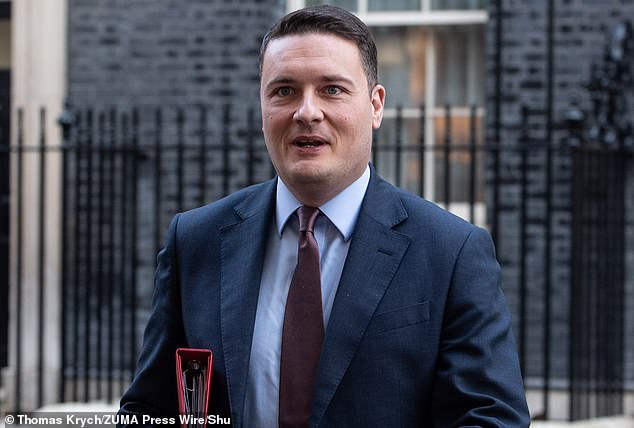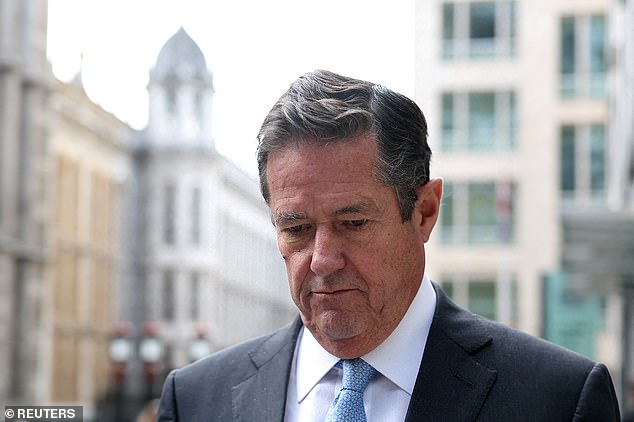Plans to cut staff numbers in half at NHS England and the Department of Health and Social Care were unveiled yesterday amid drastic cost-cutting measures.
The ‘bonfire of bureaucrats’ is aimed at removing duplication across the organisations after their workforces swelled during the pandemic.
Health secretary Wes Streeting is also seeking to tighten his control over the NHS, deliver better value for taxpayers and free-up cash for the frontline.
Three more NHS England board members yesterday announced they will quit at the end of this month, following the recent resignations of chief executive Amanda Pritchard and national medical director Professor Sir Stephen Powis.
The latest leaders to join the exodus are Julian Kelly, the chief financial officer, Emily Lawson, the chief operating officer, and Steve Russell, the chief delivery officer and national director for vaccination and screening.
NHS England is the national quango tasked with overseeing the day to day running of the health service and its long-term strategy.
It was established by the Tories in 2013 to give it greater political independence but Mr Streeting is keen to regain tighter control from within his Department.
NHS England said in a statement: ‘As part of the need to make best possible use of taxpayers’ money to support frontline services, the size of NHS England will be radically reduced and could see the size of the centre decrease by around half.’
The deeper staffing cuts follow a reduction of about 4,000 to 6,000 employees at NHS England over the past two years and about 800 at the Department of Health and Social Care.

Health secretary Wes Streeting is also seeking to tighten his control over the NHS, amid plans to cut staff numbers in half at NHS England and the Department of Health

Former NHS England chief Amanda Pritchard will step down from her position at the end of this month


NHS England chief delivery officer Steve Russell (left) and chief operating officer Emily Lawson (right) are among the latest bosses to join the exodus
Sir Jim Mackey, who will become interim chief executive at the start of April, will set up a transition team within NHS England to ‘lead the radical reduction and reshaping of the centre with the Department of Health and Social Care’.
He said: ‘We know that today’s news is unsettling for our staff, and we have significant challenges and changes ahead.‘We aim to have a transition team in place to start on the 1st April 2025 to help lead us through this period.’
Ms Pritchard said in a note to staff, seen by the Health Service Journal: ‘In the last couple of weeks, I have said I believe the time is right for radical reform of the size and functions of the centre to best support local NHS systems and providers to deliver for patients and drive the government’s reform priorities.’
She said Mr Streeting had asked Sir Jim and Penny Dash, the incoming NHS England chair, to ‘lead this work, delivering significant changes in our relationship with DHSC to eradicate duplication’.
Mr Streeting said: ‘I’d like to put on record my thanks to Julian, Emily and Steve for their dedication as public servants, and their work in particular helping steer the NHS through the pandemic.
‘I’ve enjoyed working with each of them over the last eight months and I’ve been impressed by their skill and focus on delivering improvement for patients and staff.
‘We are entering a period of critical transformation for our NHS. ‘With a stronger relationship between the Department for Health and Social Care and NHS England, we will work together with the speed and urgency needed to meet the scale of the challenge.’
As of June last year, NHS England employed just under 15,000 full-time equivalent staff, including permanent, temporary and consultancy. The Department of Health and Social Care had around 9,000, including the UK Health Security Agency. These are both around 30 per cent more than in January 2020.

NHS England chief financial officer Julian Kelly has also added his name to leaders resigning from their positions

Professor Stephen Powis, the NHS national medical director, announced last week he would step down this summer
UNISON head of health Helga Pile said: ‘Staff will be understandably concerned about this sudden change of direction.
‘The number of redundancies being sought at NHS England has trebled in just a matter of weeks.
‘Employees there have already been through the mill with endless rounds of reorganisation. What was already a stressful prospect has now become more like a nightmare.
‘Fixing a broken NHS needs a proper plan, with central bodies resourced and managed effectively so local services are supported.
‘Rushing through cuts brings a risk of creating a further, more complicated mess and could ultimately hold the NHS back. That would let down the very people who need it most, the patients.’
Matthew Taylor, chief executive of the NHS Confederation, said: ‘These changes are happening at a scale and pace not anticipated to begin with, but given the huge savings that the NHS needs to make this year it makes sense to reduce areas of duplication at a national level and for the NHS to be led by a leaner centre.
‘NHS England has already delivered significant savings and helped to deliver improvements in productivity, but national bodies and local NHS leaders know that more is needed this year.
‘These changes represent the biggest reshaping of the NHS’s national architecture in more than a decade. It is important that local NHS organisations and other bodies are involved in this transformation as the immediate next steps become clearer, so that an optimum operating model can be created.
‘This must be about doing things differently for the benefit of local communities as both patients and taxpayers, as well as for staff ahead of annual survey results on Thursday that are yet again expected to show the extreme challenges they face.’







